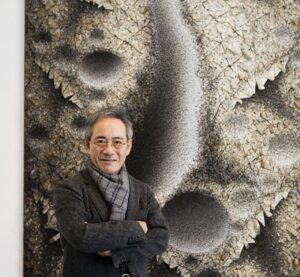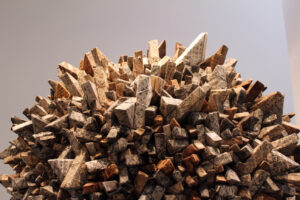Can a childhood memory become an important part of a work of art? Apparently for the South Korean artist Chun Kwang Young (b. 1944, he lives and works in Seoul), one of the most interesting and quoted of the moment, the answer is yes. In his work the childhood memory is represented by Mulberry paper that, tinted with tea or other natural pigments, allows the artist to combine painting and sculpture in surfaces animated by myriads of packets of this Korean paper. What at first glance the viewer sees in a work by Kwang Chun are large and complex sculptures, made of thousands of tiny triangular colored packages, that recall the images of the lunar surface, as if Kwang Chun’s art were something that still very few have discovered, understood and appreciated.
The universe of the South Korean artist foresees opposites (rich and poor, East and West, tradition and modernity) fighting for dominance until they are recomposed in cosmic harmony that becomes historical and social. Chun Kwang Young’s expressionist assembly, inspired by artists such as Pollock, Beuys, Rothko and others, is imbued with references to South Korean culture and the philosophy of Confucianism which envisages the sacralization of the secular, an aspect that emerges from Kwang Young’s works that become world to organically represent intra-human relationships, expressions of the transcendent and consequently of the moral nature of man.
Thanks to Chun’s ability to integrate traditional materials and especially Confucianism into the international contemporary context, this artist who sees harmony even in this hectic world, is present with his event-works in numerous public collections, including The Rockefeller Foundation and the United Nations, New York; the Woodrow Wilson International Center for Scholars, Washington, D.C.; the Philadelphia Society Building, Pennsylvania; the National Museum of Modern and Contemporary Art, Seoul and the Seoul Museum of Art; the National Gallery of Australia, Canberra; the Victoria and Albert Museum and the British Museum in London; in collections of prestigious American universities such as Yale University Art Gallery and Columbia University of Law; and the National Museum of Fine Arts, Malta.
Annalina Grasso: How and when did you get interested in art?
Chun Kwang Young: While I was studying in the United States between the ages of 20 and 30 in 1970-82 and integrated into that society, I felt a sense of difference in almost everything, including the culture of my life, my experiences and value of life. So rather than doing a new creative job, I realized that if I didn’t talk about something of my own, I realized it didn’t make sense and I wanted to go back to Korea and share my thoughts. I think mine is a true art and it doesn’t matter if everyone understands it, I understand the value of my existence when they tell me that I do something “unique”.
Annalina Grasso: How would you artistically define the historical moment we are living?
Chun Kwang Young: An era full of chaos. Before discussing art in this way, we have the feeling that we are outside the category where we have to worry and discuss art, which should seduce us, be stimulating, irritating and even childish.
Annalina Grasso: Who influenced you the most in your artistic production?
Chun Kwang Young: Joseph Beuys, Jackson Pollock, Gerhard Richter, Nam June Paik, Mark Rothko
Annalina Grasso: How is the state of health of South Korean art?
Chun Kwang Young: Even though we were a small and poor country about 100 years ago, there were works of art that are today admired in art museums around the world for their amazing culture, Confucian thoughts and academic spirit. However, during the colonial period and the great war, the values of this culture were destroyed. The result was that the culture and the arts were neglected and the economy developed considerably with the advent of the modern era. We would have liked to have had the patronage of the Medici. However, I am grateful and proud that a handful of artists with great artistry are still receiving worldwide attention, and I believe the future will be bright.
Annalina Grasso: What do you think of European art and in particular of Italian art?
Chun Kwang Young: There have been many wonderful artists mainly thanks to the development of Christianity and religious commissions, and as proof of this, there are many traces of art that the world today envies; and now that the form and method have changed, I would like to continue the new value of cutting-edge beauty.
Annalina Grasso: What do you dislike or annoy you most about contemporary art?
Chun Kwang Young: “Rise and Fall”. Whenever there is a moment of prosperity, such as a period of decline, everyone brags about the art of the past. The past has passed and we now live in a chaotic world and a time of decline. The dignity of the original value of art disappears, it should be sensational and stimulating to show our unhealthy conduct, our ugliness on the art scene, justifying it by shielding the time of change as if it were the right thing, and making it a topic for discussion. As an artist, I feel skeptical about my selective life.
Annalina Grasso: Is the world for you a sort of collision of information that creates confusion and instability?
Chun Kwang Young: I work in the hope that I can convey my correct thoughts that will remain in conflict even in the future, as I can go my own way without being blown away by the current situation even if my actions don’t get attention.
Annalina Grasso: Do you feel a sense of peace when you represent chaos your canvases or perhaps chaos does not exist for you? Is it an illusion or a creation of the media to generate panic and strengthen and increase the conflict between social classes?
Chun Kwang Young: I leave no traces of confusion in my work. Therefore, I am always happy when I work on my art. It is a precise register of me leaving my thoughts and actions while I live without being aware of the evaluation and interest of others. Therefore, I feel free and peaceful, and I am grateful and happy that God has always given me a world of unique expressions in my works. Social classes and the media world are none of my business. Sometimes I have difficulty with my path and anything else is difficult for me to discuss.
Annalina Grasso: Why did you choose abstract expressionism for your works?
Chun Kwang Young: I was born into the world, and I don’t feel the need to put it on canvas as an object of everyone’s quality of life natural objects of the world. Anyone can enjoy nature by opening the window, so I leave traces of my thoughts in my form. Just as a chef wonderfully cooks natural plants in a field and puts them on the table, I register my world by refining all the thoughts I had experienced and thought my way.
Annalina Grasso: To be a great artist, do you think that one must always investigate beyond the boundaries of the known?
Chun Kwang Young: I don’t think that’s the case. I’m interested in what a child’s world is like because I see traces of what a child is at 6 or 7 years old. If you have a clear way to explain your world to others, I think the artist’s meaning is true.
Annalina Grasso: The most beautiful exhibition you remember?
Chun Kwang Young: My favorite exhibitions are: a solo show at Aldrich Contemporary at the Brooklyn Museum (New York, USA) and, of course, there were many other beautiful ones exhibitions that touched my heart, including Joseph Beuys, Jean Michel Basquiat and Mark Rothko, Egon Schiele, Vincent Van Gogh. The artists I have mentioned who have transmitted their art in a particularly unique way.
Annalina Grasso: Upcoming commitments?
Chun Kwang Young: I’m still in good shape so I will always continue to work on new jobs with joy and happiness as I always have.
Info:
 Portrait of Chun Kwang Young, photo © Gallery & Studio Magazine, December 2014
Portrait of Chun Kwang Young, photo © Gallery & Studio Magazine, December 2014
 Chun Kwang Young, Aggregation 06-JN028, 2012, photo © Arts Observer
Chun Kwang Young, Aggregation 06-JN028, 2012, photo © Arts Observer
 Chun Kwang Young, Aggregation 12-AU042, detail photo © Arts Observe
Chun Kwang Young, Aggregation 12-AU042, detail photo © Arts Observe
 Chun Kwang Young, Aggregation 5 MA016, 2015. Mixed media with Korean mulberry paper, ph courtesy Pearl Lam Galleries
Chun Kwang Young, Aggregation 5 MA016, 2015. Mixed media with Korean mulberry paper, ph courtesy Pearl Lam Galleries
 Chun Kwang Young, Aggregation 14-NV054 (Dream 19), 2014. Mixed media with Korean mulberry paper, ph courtesy Pearl Lam Galleries
Chun Kwang Young, Aggregation 14-NV054 (Dream 19), 2014. Mixed media with Korean mulberry paper, ph courtesy Pearl Lam Galleries
Journalist, blogger and social media editor from Campania. i graduated in literature and philology and I gained a master in art and organization of cultural events. I love cinema, art, music, literature, especially Russian, French and Italian. I read a lot, both narrative and non-fiction. I share Picasso’s thoughts on art: “Art helps us to recognize the truth”.






NO COMMENT